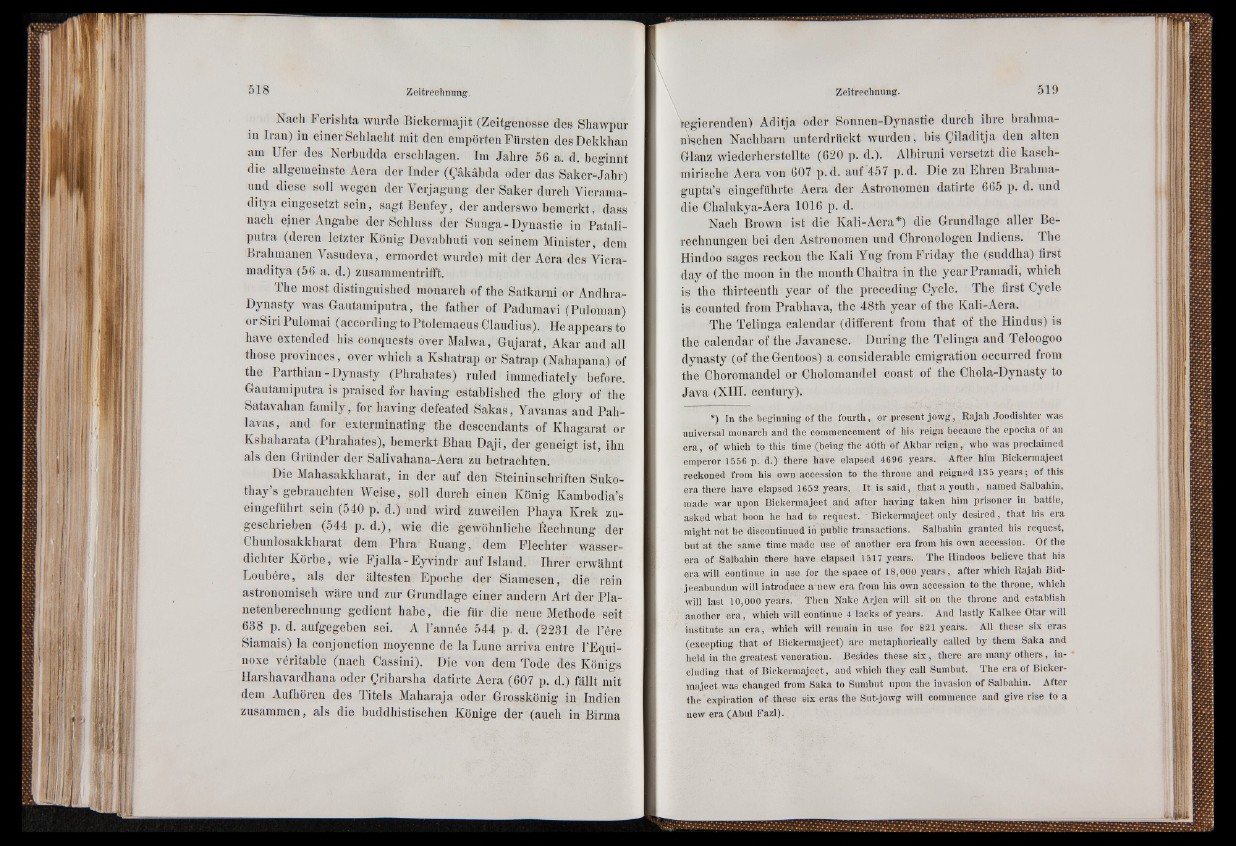
Nach Ferishta wurde Bickermajit (Zeitgenosse des Shawpur
in Iran) in einer Schlacht mit den empörten Fürsten desDekkhan
am Ufer des Nerbudda erschlagen. Im Jahre 56 a. d. beginnt
die allgemeinste Aera der Inder (Çâkâbda oder das Saker-Jahr)
und diese soll wegen der Verjagung der Saker durch Vicrama-
ditya eingesetzt sein, sagt Benfey, der anderswo bemerkt, dass
nach einer Angabe der Schluss der Sunga - Dynastie in Patali-
putra (deren letzter König Devabhuti von seinem Minister, dem
Brahmanen Vasudeva, ermordet wurde) mit der Aera des Vicra-
maditya (56 a. d.) zusammentrifft.
The most distinguished monarch of the Satkarni or Andhra-
Dynasty was Gautamiputra, the father of Padumavi (Puloman)
or Siri Pulomai (according to Ptolemaeus Claudius). He appears to
have extended his conquests over Malwa, Gujarat, Akar and all
those provinces, over which a Kshatrap or Satrap (Nahapana) of
the Parthian - Dynasty (Phrahates) ruled immediately before.
Gautamiputra is praised for having established the glory of the
Satavahan family, for having defeated Sakas, Yavanas and Pah-
lavas, and for exterminating the descendants of Khagarat or
Kshaharata (Phrahates), bemerkt Bhau Daji, der geneigt ist, ihn
als den Gründer der Salivahana-Aera zu betrachten.
Die Mahasakkharat, in der auf den Steininschriften Suko-
thay s gebrauchten Weise, soll durch einen König Kambodia’s
eingeführt sein (540 p. d.) und wird zuweilen Phaya Krek zugeschrieben
(544 p. d.), wie die gewöhnliche Rechnung der
Chunlosakkharat dem Phra Ruang, dem Flechter wasserdichter
Körbe, wie Fjalla-Eyvindr auf Island. Ihrer erwähnt
Loubère, als der ältesten Epoche der Siamesen, die rein
astronomisch wäre und zur Grundlage einer ändern Art der Planetenberechnung
gedient habe, die für die neue Methode seit
638 p. d. aufgegeben sei. A l’année 544 p. d. (2231 de l’ère
Siamais) la conjonction moyenne de la Lune arriva entre l’Equi-
noxe véritable (nach Cassini). Die von dem Tode des Königs
Harshavardhana oder Çriharsha datirte Aera (607 p. d.) fällt mit
dem Aufhören des Titels Maharaja oder Grosskönig in Indien
zusammen, als die buddhistischen Könige der (auch in Birma
regierenden) Aditja oder Sonnen-Dynastie durch ihre brahma-
nischen Nachbarn unterdrückt wurden, bis Qiladitja den alten
Glanz wiederherstellte (620 p. d.). Albiruni versetzt die kasch-
mirische Aera von 607 p. d. auf 457 p.d. Die zu Ehren Brahmagupta’s
eingeführte Aera der Astronomen datirte 665 p. d. und
die Chalukya-Aera 1016 p. d.
Nach Brown ist die Kali-Aera*) die Grundlage aller Berechnungen
bei den Astronomen und Chronologen Indiens. The
Hindoo sages reckon the Kali Yug from Friday the (suddha) first
day of the moon in the month Chaitra in the year Pramadi, which
is the thirteenth year of the preceding Cycle. The first Cycle
is counted from Prabhava, the 48th year of the Kali-Aera.
The Telinga calendar (different from that of the Hindus) is
the calendar of the Javanese. During the Telinga and Teloogoo
dynasty (of the Gentoos) a considerable emigration occurred from
the Choromandel or Cholomandel coast of the Chola-Dynasty to
Java (XIII. century).
*) In the beginning of the fo urth, or present jowg., Rajah Joodishter was
universal monarch and the commencement of his reign became the epocha of an
e ra , of which to this time (being the 40th of Akbar re ig n , who was proclaimed
emperor 1556 p. d.) th ere have elapsed 4696 years. After him Bickermajeet
reckoned from his own accession to the throne and reigned 135 y e a rs ; of this
e ra th ere have elapsed 1652 years. I t is s a id , th a t a you th , named Salbahin,
made war upon Bickermajeet and after having taken him prisoner in battle,
asked what boon he had to request. Bickermajeet only desired, th a t his era
might not be discontinued in publie transactions. Salbahin granted his request,
but a t the same time made use of another era from his own accession. Of the
era of Salbahin there have elapsed 1517 years. The Hindoos believe th a t his
era will continue in use for the space of 18,000 y e a rs , after which Rajah Bid-
jeeabundun will introduce a new era from his own accession to the throne, which
will last 10,000 years. Then Nake Arjen will sit on the throne and establish
another e ra , which will continue 4 lacks of years. And lastly Kalkee Otar will
institute an e ra , which will remain in use for 821 years. All these six eras
(excepting th a t of Bickermajeet) a re metaphorically called by them Saka and
held in the greatest veneration. Besides these s ix , there are many o th e rs , including
th at of Bickermajeet, and which they call Sumbut. The e ra of Bickermajeet
was changed from Saka to Sumbut upon the invasion of Salbahin. After
the expiration of these six eras the Sut-jowg will commence and give rise to a
new era (Abul Fazl).